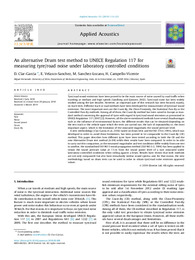Por favor, use este identificador para citar o enlazar este ítem:
https://hdl.handle.net/11000/33430Registro completo de metadatos
| Campo DC | Valor | Lengua/Idioma |
|---|---|---|
| dc.contributor.author | Clar Garcia, David | - |
| dc.contributor.author | VELASCO SANCHEZ, EMILIO | - |
| dc.contributor.author | Sanchez Lozano, Miguel | - |
| dc.contributor.author | Campello Vicente , Héctor | - |
| dc.contributor.other | Departamentos de la UMH::Ingeniería Mecánica y Energía | es_ES |
| dc.date.accessioned | 2024-10-07T08:06:47Z | - |
| dc.date.available | 2024-10-07T08:06:47Z | - |
| dc.date.created | 2019-08 | - |
| dc.identifier.citation | Applied Acoustics, Volume 151, August 2019, Pages 113-123 | es_ES |
| dc.identifier.issn | 1872-910X | - |
| dc.identifier.issn | 0003-682X | - |
| dc.identifier.uri | https://hdl.handle.net/11000/33430 | - |
| dc.description.abstract | Tyre/road sound emissions have been proved to be the main source of noise caused by road traffic when traveling at medium and high speeds (Sandberg and Ejsmont, 2002). Tyre/road noise has been widely studied among the last decades. However, an important part of this research has been focused, mainly, on track tests. Different track or road methods have been developed for measurement of tyre/road sound emissions. The most important ones are the Coast-By, the CloseProximity, the Statistical Pass-By or the Controlled Pass-By methods. Among all of them, the Coast-By method has been raised in Europe as stan-dard method concerning the approval of tyres with regard to tyre/road sound emissions as preconized in UNECE Regulation 117 (2007)[2]. However, all the above mentioned methods have several disadvantages such as the influence of environmental factors, the different results that can be obtained depending on the test track or the vehicle upon which the tests are carried out, the lack of repeatability or, the most important aspect, which is the limitation of the measured magnitude, the sound pressure level. A new methodology (Clar-Garcia et al., 2016) based on drum tests and the ISO 3744 (1994), which was developed in order to avoid these limitations, has been proved to be comparable to the Coast-By (CB) method. This paper describes how different tyres have been tested according to both the CB and the new Alternative Drum test method (A-DR) while their results have been compared. In order to be able to carry out this comparison, as the measured magnitudes and test conditions differ widely from one test to another, the standardised ISO 9613 sound propagation method (ISO 9613-2, 1996) has been applied to obtain the sound pressure value at 7.5 m from the sound power level of a tyre measured under laboratory-controlled conditions when rolling against a drum. Results have shown that both methods are not only comparable but also have remarkably similar sound spectra and, for that reason, the new methodology based on drum tests can be used in order to obtain tyre/road noise emission approved values. | es_ES |
| dc.format | application/pdf | es_ES |
| dc.format.extent | 11 | es_ES |
| dc.language.iso | eng | es_ES |
| dc.publisher | Elsevier | es_ES |
| dc.rights | info:eu-repo/semantics/openAccess | es_ES |
| dc.rights | Attribution-NonCommercial-NoDerivatives 4.0 Internacional | * |
| dc.rights.uri | http://creativecommons.org/licenses/by-nc-nd/4.0/ | * |
| dc.subject | Tyre | es_ES |
| dc.subject | Noise | es_ES |
| dc.subject | Sound power | es_ES |
| dc.subject | Drum | es_ES |
| dc.subject | Coast-By | es_ES |
| dc.subject.other | CDU::6 - Ciencias aplicadas::62 - Ingeniería. Tecnología | es_ES |
| dc.title | An alternative Drum test method to UNECE Regulation 117 for measuring tyre/ road noise under laboratory controlled conditions | es_ES |
| dc.type | info:eu-repo/semantics/article | es_ES |
| dc.relation.publisherversion | https://doi.org/10.1016/j.apacoust.2019.03.005 | es_ES |

Ver/Abrir:
2019 - An alternative method to UNECE Regulation 117.pdf
3,32 MB
Adobe PDF
Compartir:
 La licencia se describe como: Atribución-NonComercial-NoDerivada 4.0 Internacional.
La licencia se describe como: Atribución-NonComercial-NoDerivada 4.0 Internacional.
.png)